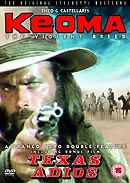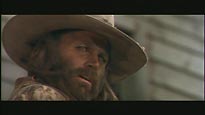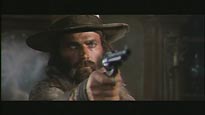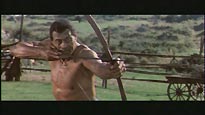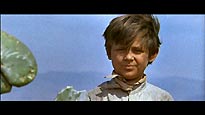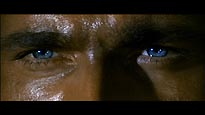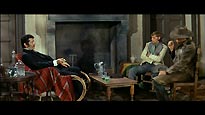|
KEOMA / TEXAS, ADIOS Argent's Region 2 Edition KEOMADirector: Enzo G. CastellariFeaturing: Franco Nero, Woody Strode, William Berger, Donald O'BrienReviewed by Mark Frost
THE FILM It’s quite safe to say that to most people, Spaghetti Westerns begin and end with Sergio Leone. His ‘Dollars’ trilogy (A Fistful of Dollars, For a Few Dollars More and The Good, The Bad, and The Ugly) was so revolutionary that they changed Westerns overnight, effectively saying goodbye to the American Western – leaving it with nowhere to go, and ushering in a new breed of film that is still being made today. But what if you want to look beyond Sergio Leone and discover more of the genre – where would you start? In the ten-year period following A Fistful of Dollars’ release, literally thousands of Spaghettis were made. What with all of your Ringo’s, Sabata’s and Trinty’s, it can be quite a daunting prospect. I always suggest starting with the work of Franco Nero, an excellent actor who never quite got the break he needed in America. His breakthrough role overseas came in the form of Django, a dirty, atmospheric Western that really showed what the genre was capable of. Over the next few years he was involved in other great entries in the cycle, including Companeros, A Professional Gun, and what I believe to be the finest non-Leone Spaghetti Western ever made – Keoma: The Violent Breed. Keoma (Franco Nero), a battle weary half breed, returns home after many years away fighting in the civil war, to discover that his home town has been overrun by Caldwell, a ruthless land owner. The plague has descended upon the area and Caldwell, with Keoma’s three half brothers in his employ, uses this as an excuse to drive the inhabitants out and seize control of the town. Now Keoma must free his hometown from the viscous stranglehold, save the life of a pregnant widow, and try to salvage the relationship between himself and his family. By 1976, when Keoma was made, the Spaghetti Western was all but finished. The same people who had created it had also killed it off, with each entry being more cruel, masochistic and inhuman than the last. Sergio Leone had added a hint of sadistic violence to his Westerns and made the world sit up and take notice, Italian producers could not see beyond this to the style and talent of Leone, so they proceeded to churn out film after film based on violence and not much else. By the early seventies the genre had evolved, and directors were using the medium as a portal to vent their political opinions, often telling a story that had parallels with modern day Italy or Mexico. Some truly great Westerns were produced over this period - Face to Face, A Bullet for the General – but the big budget Hollywood entry A Fistful of Dynamite signalled the death of this offshoot. Not forgetting the introspective efforts such as Once Upon A Time in the West and My Name Is Nobody that looked at the genre from the outside in, deconstructing the conventions and not treating the old West as myth, but the Western itself. So where had the Western left to go? It had turned in every direction it could, destined to run out of steam until it was left looking back at itself. The answer was back to the start, but with knowledge of the road it had travelled. Nothing about Keoma is tired and expected. It takes you completely by surprise on the first viewing. If this is supposed to be a Western, then why is the town surrounded by lush green hills? The filmmakers’ love for the genre is obvious from the outset, with what looks like every energy thrown into making this last hurrah something to remember. Director Enzo G. Castellari composes every frame with care, creating a film full of consistently impressive compositions that are both visually striking and meaningful. Tired conventions of the Spaghetti are given a new lease of life – the flashbacks ingeniously keep you within the timeframe of the story without bringing the film to a halt; the violence is spectacularly shot in an obviously-Peckinpah-inspired style that manages to be both fresh and welcome; and the ‘lone man’ motif employed here, as in nearly all that preceded, is used not just for laconic effect but for the very narrative structure itself. Not content with a solid Western story, Castellari infuses the piece with an existential quality, creating characters that are literal representations of life and death, affecting the players who cross their path. This search for a deeper meaning should have made the picture an embarrassing mess, but the supreme confidence in what the filmmakers were making has actually given the movie an edge over similar efforts, with you as the viewer searching for significant meaning in compositions, characters and situations. Castellari freely admits that he borrowed from Peckinpah, Bergman, Leone, etc. Regardless, he has managed to fashion a superb mix of all these influences and his own talent to create a film that excels in so many areas. I challenge you to find a better use of extended slow motion in conjunction with score to create the heart pounding moment when Keoma’s father is captured. Yes, you heard me right – I praised the score. The most controversial aspect of Keoma is the music supplied by the De Angelis Brothers. You will find it very hard to track down a review of Keoma that doesn’t slate the soundtrack. Those expecting the typical Morricone-style guitar twangs and harmonica will get quite a surprise. What you get instead is something akin to Kate Bush being chased through a tube tunnel with a TASER. The first taste you get of the score is bewildering – a woman screams and warbles her way through lyrics that, for the most part, actually tell us what is happening and what that character may be thinking at that time, no matter how obvious. The first time you hear it it’s off-putting, to say the least, but I personally believe it is massively important element, the kind that sets Keoma apart from the competition, rendering it the unique experience that it is. After multiple watches I wouldn’t have it any other way. A large nod must be given to the main cast. Apart from the aforementioned Franco Nero, there is William Berger – veteran of many Spaghettis, and totally believable as Keoma’s father, even though he and Franco Nero are almost the same age. And, in his last great role, it is Sergeant Rutledge himself – Woody Strode – playing the family friend George, an ex-slave who has turned to drink in the years Keoma has been away. Strode is magnificent, giving the character great dignity and enough weight to shoulder the social subplot, concerning the racism that George and half-Indian Keoma suffer from the three brothers.
THE DISCPictureThe film is presented in anamorphic 2:35:1 widescreen, at an average bitrate of 6.98Mb/s. The image is washed out and quite blurry. The film has obviously not been re-mastered, as many imperfections appear on the screen, from dust, to burns to excessive grain. It is not all doom and gloom, however – it is perfectly watchable, and certainly the best it has been available in Britain. The reason I am negative is because it suffers by comparison - I was horrified to see that the clips shown in the two interviews on the disc show detailed contrast and sharpness, outperforming the actual film image. How on earth is this allowed to happen? Secondly, Anchor Bay has released a region 1 version with far superior picture quality. The image on the American disc is warm and detailed, not remastered, but very stable and highly agreeable to those who only sampled the film on VHS. Argent has missed an opportunity here. SoundNobody puts a Spaghetti Western in their player expecting a perfect quality soundtrack. Due to the recording techniques and dubbing employed, the tracks tend to be a bit shaky – but that’s all part of the experience and should not be penalised. The audio here is mono at 192kbps and sounds adequate. It doesn’t excel in any department but is clear and reliable. It’s the original soundtrack, unmolested, and that’s all that matters. BONUS FEATURESApart from the assorted trailers of coming attractions from Argent, there are two extras on the disc: An Interview with Enzo G. Castellari (15m 16s) - Castellari obviously has a great love for this film, and is hugely proud of it. The interview is just one camera shot interspersed with clips, in which Castellari tells anecdotes about the filming – informing us that they threw out the script before shooting and made up the story one day at a time, with the whole cast helping. There is a lovely anecdote about Woody Strode that almost brings the interviewee to tears.Introduction by Alex Cox (5m 16s) - I’ve always got time for Alex Cox when it comes to Spaghetti Westerns, as the BBC Moviedrome showing of Django Kill was what got me interested in Spaghetti Westerns past Leone. Not to mention the fact that he has made his own – Straight To Hell. He doesn’t really say anything too meaningful here, but given that he’s only got 5 minutes, you can’t blame him. SUMMARYAs I stated in the first paragraph, this is my favourite non-Leone Spaghetti Western so I am a little bias when it comes to recommending this film. The disc itself from Argent I cannot recommend so heartily, as there is a better option in the form of the region 1 Anchor Bay disc. The region 2 gains the Enzo G. Castellari interview and the Alex Cox introduction, but loses the director’s commentary and Franco Nero interview from the US disc. But, if you only have a region 2 player, then you really have no excuse not to get this fantastic film presented on an acceptable disc. TEXAS, ADIOSDirector: Ferdinando BaldiFeaturing: Franco Nero, Alberto Dell'Acqua, Livio LorenzonReviewed by Matt West
THE FILM Franco Nero. What a terrific name. It sounds almost like a Bingo call. If you’ve not heard of Franco Nero then allow me to help you out – he was in DIE HARD 2. I’ll be amazed if the DVD box of this film doesn’t say that: “Franco DIE HARD 2 Nero”. Tsk. The man is, was, and always shall be a legend… probably one of Italy’s greatest stars. And in this film you can see the seeds being sown for his later, greater, Keoma. Enough about Franco Nero, the hero. Texas, Adios (the title on this particular print of the film) is pretty much a run-of-the-mill Western. There’s nothing particularly outstanding about it – all the elements are in place: Sheriff quits his job to get revenge on the man that killed his father, and takes his little brother with him. Massive Empire Strikes Back-style ending with a twist. And we even have the townspeople armed and fighting back. It’s difficult to pinpoint the appeal of Texas, Adios. It’s a very easy, very fluid film to watch with a terrific soundtrack and occasional surprising direction. When I was at college with fellow Zeta Minor reviewer Mark Frost – we started to buy up as many of the Spaghetti Western videos as we could. Not the Hollywood junk – but stuff like Texas, Adios, Bullet For The General, Keoma and Django etc. The major appeal being that they were budget priced videos and in widescreen. We never got a bad one. They were all watchable. But times have moved on now. That’s well over ten years ago and DVD has since taken over. It’s taken quite a while for those films to come back to us in the new format and one would expect them to be nothing short of amazing – wouldn’t one? THE DISC Well, in the case of Texas, Adios we have some sorry news. I was really looking forward to seeing this disc with a crisp new transfer, Italian dialogue, all the pixel-sharp Franco Nero money can buy. I couldn’t be more disappointed with the transfer on this disc. It’s almost like watching a £5 Petrol Station DVD… and yet it really shouldn’t be. Other Italian cinema, especially the giallo and the horror titles, are getting incredible releases from the likes of Anchor Bay, Blue Underground and even Media Blasters. The film is presented in 2.35:1 anamorphic format, with Dolby Digital 2.0 audio (at 192kbps), split into thirteen chapters. The bitrate lingers around the low sixes and rarely braves the sevens during the main feature. However the non-skippable logos at the start of the film are presented in glorious 8Mb/s!! Even the black bits. The menu is gorgeous. Garish, and retro with a stylised dirt and film grain look. That is until you play the film and realise that that’s exactly what you’re getting! There’s a two and a half minute trailer on the disc as well, which seems to have been sourced from slightly better materials. That’s your only extra – in spite of Nero and Baldi still being alive. SUMMARY I am really disappointed with this disc and hopefully it’s not a sign of things to come from new boys Argent. The A-side of this disc features KEOMA. This seems to have had much better treatment. Good luck, Argent – we’re all counting on you.
|
|||||||||||||||||||


